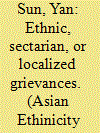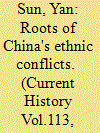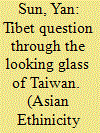|
|
|
Sort Order |
|
|
|
Items / Page
|
|
|
|
|
|
|
| Srl | Item |
| 1 |
ID:
163426


|
|
|
|
|
| Summary/Abstract |
Previous scholarship has identified an emerging consensus for ethnic-policy reform in China, in the direction of strengthening national integration and a ‘melting pot.’ This article identifies three major contending schools in Chinese debates about the country’s ethnic governance: liberal autonomists, integrationists and socialist autonomists. It argues that the socialist autonomists, who oppose the ‘melting pot,’ have prevailed politically. Contention among the three schools, specifically, revolves around tradeoffs between autonomy and ethnic particularism. That is, compromised autonomy but preferential policies. The liberal autonomists reject the tradeoffs because of the cost to autonomy. The integrationists reject the tradeoffs because of the divisive role of ethnic particularism. The socialist autonomists, however, embrace the tradeoffs because of the developmental and distributional benefits. With the leftward turn of the Xi Jinping regime, they have prevailed ideologically and politically to safeguard the current system from any fundamental change.
|
|
|
|
|
|
|
|
|
|
|
|
|
|
|
|
| 2 |
ID:
126666


|
|
|
|
|
| Publication |
2013.
|
| Summary/Abstract |
Since its ?rst occurrence in 2009. the total number of Tibetan self-immolations had reached 97 by the end of 20l2. with an additional 10 or so in the fu'st three months of 20l3. However. our understanding of this shocking act remains limited. Why did those Tibetans resort to such an extreme form of protest? What were their motives? What were their grievances'? What objectives did they intend to achieve? Wang Lixiong. a dissident Chinese scholar-writer and respected authority on Tibetan affairs, attempts to answer these questions by analyzing the last words of more than two dozen self-immolators who had left final notes.' His data are derived from infomiation collected by his Tibetan wife. Woeser. who is also a dissident writer. Below I will introduce Wang's major ?ndings and evaluate them in the light of two competing perspectives
|
|
|
|
|
|
|
|
|
|
|
|
|
|
|
|
| 3 |
ID:
192133


|
|
|
|
|
| Summary/Abstract |
Since late 2016, Ningxia has drawn attention as a new target in Beijing’s drive to ‘Sinicize Islam.’ The removal of overt signs of the Islamic faith and Arab influences is viewed as representing a new front in the CCP’s sweeping rollback of religious freedom. Is Ningxia another Xinjiang as both the party and its critics fear? This paper argues that it is not at the empirical level but shares with Xinjiang key underlying dynamics at the systemic level. At the empirical level, Ningxia’s ‘Islamization’ stemmed largely from local authorities’ use of the Islamic part of Ningxia’s heritage as a developmental strategy, leading to so-called pan-Halalfication, Saudization and Arabization. In contrast to more complex social dynamics in Xinjiang, Ningxia’s ‘Islamization’ can be more easily dealt with by withdrawing the local state’s own promotion. At the systemic level, the rise and fall of Islamization in Ningxia share with Xinjiang’s case the critical role of the state in affecting the fate of religion for significant ethno-religious communities.
|
|
|
|
|
|
|
|
|
|
|
|
|
|
|
|
| 4 |
ID:
125604


|
|
|
|
|
| Publication |
2013.
|
| Summary/Abstract |
Municipal solid waste (MSW) is regarded as a renewable energy source. In China, the sharp increase of MSW has precipitated the rapid growth of waste-to-energy (WTE) incineration plants. Private capital has been getting into the WTE incineration industry through the public-private partnership (PPP) arrangement. Due to the large construction cost and the long concession period commonly associated with this arrangement, a number of failures have emerged in PPP WTE incineration projects. The aim of this paper is to investigate the key risks of PPP WTE incineration projects in China and study the strategies for managing these risks by drawing experience and learning lessons from these projects. First, we analyzed the MSW management practices, relevant legislations and policies, and the development of PPP WTE incineration projects in China. Second, we identified ten key risks through interviews, surveys and visits to some selected projects, and provided detailed analysis of these risks. Lastly, we developed response strategies for these risks from the perspectives of both public and private sectors.
|
|
|
|
|
|
|
|
|
|
|
|
|
|
|
|
| 5 |
ID:
134001


|
|
|
|
|
| Publication |
2014.
|
| Summary/Abstract |
A surge of ethnic violence in China in recent years has revealed growing social tensions in a country beset by developmental strains, with a political system lagging behind epic economic change. In the first half of 2014 alone, there were at least five instances of what the state defines as terrorism associated with Xinjiang, the Muslim borderland in the west. A May attack at a vegetable market in Urumqi, Xinjiang's capital, killed 43 people. In August, clashes in Xinjiang left nearly 100 dead. And the spread of violence to other provinces-notably in Beijing's Tiananmen Square last October and at the rail station in the southwestern city of Kunming this March- has brought home the reality of ethnic tensions to Chinese citizens outside sensitive minority regions.
|
|
|
|
|
|
|
|
|
|
|
|
|
|
|
|
| 6 |
ID:
107677


|
|
|
|
|
| Publication |
2011.
|
| Summary/Abstract |
This paper evaluates the Tibet question through the looking glass of Taiwan, by considering four dimensions of comparative dynamics between the two cases of Taiwan and the Tibetan government-in-exile (TGIE) in relation to China: territorial, economic, ethnic and cultural. Of the four, the paper argues, Taiwan has high convergence with China in the economic, ethnic and cultural dimensions, and managed divergence in the territorial dimension. The TGIE, on the other hand, has high divergence with China in all four dimensions: territorial dispute, economic incongruence, ethnic estrangement, and cultural gulf. Further, the TGIE is ideologically and sentimentally charged by this divergence and thrives by exploiting it. It therefore should have few incentives to see the lessons of Taiwan applied in resolving the Tibet question.
|
|
|
|
|
|
|
|
|
|
|
|
|
|
|
|
|
|
|
|
|